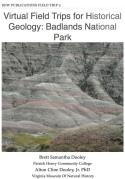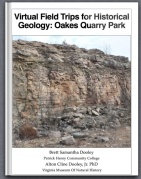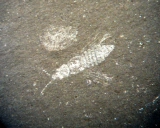 Nick Fraser, the current Keeper of Natural Sciences at the National Museum of Scotland, used to be Director of Research and Collections at VMNH, and essentially created our Department of Vertebrate Paleontology. One of the results of Nick’s tenure here was that VMNH now houses a fairly large collection of Triassic fossils from Britain (only fair, considering how many Virginia fossils were shipped to Britain during the 1800s!).
Nick Fraser, the current Keeper of Natural Sciences at the National Museum of Scotland, used to be Director of Research and Collections at VMNH, and essentially created our Department of Vertebrate Paleontology. One of the results of Nick’s tenure here was that VMNH now houses a fairly large collection of Triassic fossils from Britain (only fair, considering how many Virginia fossils were shipped to Britain during the 1800s!).
These fossils were collected from what are known as “fissure-fill” deposits. These were caves and sinkholes during the Triassic, formed by the dissolution of Lower Carboniferous limestones. As numerous Miocene to Pleistocene cave deposits have demonstrated, if you have a cave then animals will fall into it and die (or, at least their bodies will get washed in). Things were apparently no different in the Triassic, and the fissure-fill deposits are full of disarticulated bones of small Triassic animals. These can be removed from the rock by using acetic acid to dissolve the limestones.
One of the interesting animals recovered from these deposits and housed at VMNH is Agnosphitys cromhallensis, described by Fraser et al. (2002). The type specimen is an isolated left ilium (part of the pelvis), shown above. Several other remains were referred to the same species, including a left maxilla (one of the tooth-bearing bones in the upper jaw)…
 …and a left astragalus (an ankle bone):
…and a left astragalus (an ankle bone):
 Agnosphitys is an interesting animal in part because it sits close to the ancestry of dinosaurs, its exact position being somewhat controversial. Fraser et al. (2002) considered it to be just outside of the Dinosauria based on two features. First, Agnosphitys has a brevis fossa, a depression in the ilium right behind the hip socket (visible in the photo at the top, on the right side of the image). The second feature is that Agnosphitys apparently only had two sacral vertebrae (vertebrae attached to the hip), while dinosaurs all had at least three. This would put Agnosphitys just outside of the dinosaurs, and closer to them than Herrerasaurus (which according to Fraser et al. has only a hint of a brevis fossa).
Agnosphitys is an interesting animal in part because it sits close to the ancestry of dinosaurs, its exact position being somewhat controversial. Fraser et al. (2002) considered it to be just outside of the Dinosauria based on two features. First, Agnosphitys has a brevis fossa, a depression in the ilium right behind the hip socket (visible in the photo at the top, on the right side of the image). The second feature is that Agnosphitys apparently only had two sacral vertebrae (vertebrae attached to the hip), while dinosaurs all had at least three. This would put Agnosphitys just outside of the dinosaurs, and closer to them than Herrerasaurus (which according to Fraser et al. has only a hint of a brevis fossa).
There has been some dispute about this interpretation of Agnosphitys (see the discussion in this 2007 post from Tetrapod Zoo). Some of the basis for the dispute concerns not so much the interpretation of Agnosphitys as how Dinosauria is defined; if dinosaurs are not defined based on the presence of at least three sacral vertebrae, then Agnosphitys can be interpreted as a true dinosaur rather than a dinosaur relative (this seems to be the current position of many paleontologists working on this group). These are the types of issues that systematic paleontologists debate endlessly! Any dinosaur workers that wish to chime in with more up-to-date information are welcome to do so, since I don’t keep up with all the latest literature on dinosaur origins.
Another issue is that the different described bones of Agnosphitys do not come from a single skeleton. It is possible that the bones represent more than one species of animal, although many of the critical identification features are found in the ilium. The association of these bones with one another is quite reasonable, but it is possible that some future discovery could show that more than one species is represented.
This is a fascinating specimen, and a nice (and somewhat surprising) one to find in Martinsville.
Reference:
Fraser, N. C., K. Padian, G. M. Walkden, and A. L. M. Davis, 2002. Basal dinosauriform remains from Britain and the diagnosis of the Dinosauria. Palaentology 45:79-95.
***
I apologize for the week-long hiatus in my posts. I am recovering from a bout of the flu, which has considerably slowed me down over the last week. I also have several major projects (including two exhibits) that are going to be keeping me very busy over the next 2 months, but I’ll do my best to post regularly.











“Any dinosaur workers that wish to chime in with more up-to-date information are welcome to do so, since I don’t keep up with all the latest literature on dinosaur origins.”
Can do. 🙂
The phylogeny in Fraser et al. (2002) was outdated, since basically every other analysis since Herrerasaurus was redescribed by Sereno and Novas in 1993 placed that taxon in Dinosauria and Saurischia. Moreover, to my knowledge no one has defined Dinosauria using sacral number (it’s universally defined as the common ancestor of Ornithischia and Saurischia and all of its descendents), though that feature has diagnosed Dinosauria in many phylogenies. Herrerasaurus, Eoraptor and Staurikosaurus are now known to have had three sacral vertebrae after all (Sereno, 2007; Bittencourt and Kellner, 2009), making the number in the disarticulated Agnosphitys questionable. Its well developed brevis fossa would merely exclude it from Herrerasauridae. The only two authors to include Agnosphitys in phylogenetic analyses so far found it to be a basal theropod (Yates, 2007) or a guaibasaurid sauropodomorph (Ezcurra and Novas, 2009).
Thanks, Mickey!
As I recall, I think Fraser et al. allowed the possibility that there could be more than two sacrals (although they clearly believed that there were only two). Even in their tree, that would push those primitive taxa into Dinosauria, with Agnosphitys more derived than Herrerasaurus.
I wasn’t aware of the referral of Agnosphitys to the Guaibasauridae; too much literature to keep up with!
Bill Parker at Chinleana (http://chinleana.blogspot.com/) also has some discussion of Agnosphitys, with additional references.
Interesting. I have heard so much about dinosaurs but little on where they originated, taxonomy wise. Lagosuchus was one critter i once heard of as being ancestral to the dinosaur line.
If I recall correctly, Lagosuchus (which I think isn’t well known) and the related, better-known Marasuchus, are more primitive than these taxa. I think Marasuchus is considered an early, primitive dinosauriform, while Agnosphitys is apparently an early dinosaur (or a very advanced dinosauriform according to Fraser et al.).
Well, that one is so far just an SVP meeting abstract. But the talk was very convincing.
BTW, the definition of Dinosauria is “the most recent common ancestor of Megalosaurus, Iguanodon, and Scelidosaurus, plus all its descendants”. If Agnosphitys is one of those descendants (and the number of sacral vertebrae is just one character that can help us find that out), it is a dinosaur; if not, then not.
The type specimen of Lagosuchus is now considered an undiagnostic basal dinosauromorph. Better referred materials were re-named Marasuchus, which is a basal dinosauromorph that is also the most-basal dinosauriform.
Ooh… that maxilla is really pretty. What a little gem! I’m surprised how many dinosaur lurkers are on here.
Very nice pictures on Agnosphitys!
The paper in which I reconsider Agnosphitys as a guaibasaurid sauropodomorph is currently in press at Journal of Systematic Palaeontology. In this paper I describe a new species of basal dinosaur from the Ischigualasto Formation which is very closely related to Saturnalia.